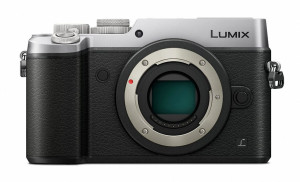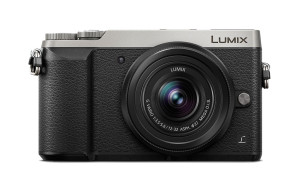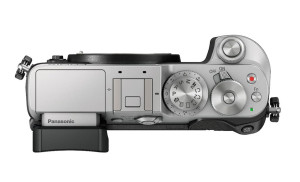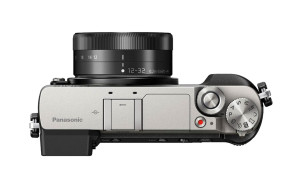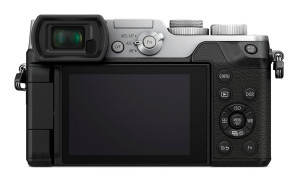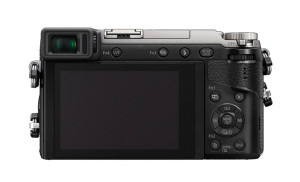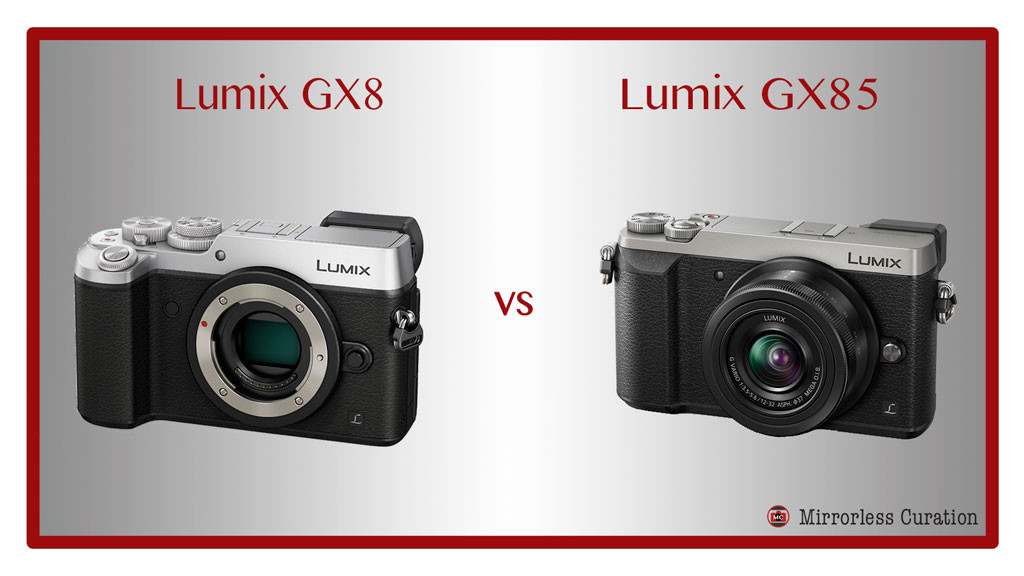
The Panasonic GX85 (North American name) / GX80 (European name) appears to be the natural successor to the GX7 if you only consider its size. However, the technology inside the new camera places it much closer to its big brother, the Lumix GX8. In fact, certain aspects of the GX85 are even more advanced than the GX8 such the stabilisation system. But let’s look at the similarities first.
Both cameras have 4K video capabilities with various 4K PHOTO options including 4k Burst and Post Focus. They both incorporate a contrast detection AF system with Panasonic’s DfD (Depth from Defocus) technology and they can shoot up to 8fps (AF-S) and 6fps (AF-C).
Despite having a lower price and smaller dimensions, the GX85 features many improvements in comparison to the previous GX cameras. In the comparison below, we share the 10 main differences between the GX85/GX80 and the GX8.
Ethics statement: The following list is based upon our experience with Lumix cameras and official specifications. We were not asked to write anything about these cameras, nor were we provided any compensation of any kind. All opinions we express are our own. Within the article, there are affiliate links. If you buy something after clicking the link, we will receive a small commission. To know more about our ethics, you can visit our full disclosure page. Thank you!
1. Size and weight
Of course the main difference that immediately stands out is the reduced size of the GX85. It is around 1cm smaller (0.7cm less in height) and about 2cm thinner (grip included). However the weight of the two cameras is closer than we would expect. The GX8 is around 487g while the GX85 is about 426g (with the battery and SD card included) so we are talking about a difference of 60g.
We can also point out the GX8’s more prominent grip which makes the camera easier to use with larger lenses like the 100-400mm.
Both cameras come in black and silver/black. The GX85 will be available in faux brown leather in select countries.
2. Buttons, dials and ease of use
The GX85, because of its smaller size, has had to sacrifice a few extra dials and buttons that we find quite handy on the GX8. There is no exposure compensation dial or AF mode selector on the smaller camera. The GX8 also has two extra Fn buttons (including one on the front and two on top) for a total of 7 physical buttons in comparison to 5 on the GX85.
The GX85 lacks an audio input or output while the GX8 has a mic input. It is a 2.5mm type that requires an adapter to be compatible with the standard 3.5mm jack input.
On both cameras, the front/rear dial can be used as a dual solution to change the shutter speed/aperture and ISO/White Balance.
3. Image sensor
The GX8 features a 20MP sensor which is the most recent chip for the Micro Four Thirds system. (It also used inside the Olympus Pen F.)
The GX85 has a 16MP sensor but, with no low-pass filter, it should resolve fine detail 10% better than previous 16MP sensors.
Both cameras have a native ISO range of 200 to 25600 with a pull value of 100.
3. Dual Image Stabilisation system
The GX7 was Panasonic’s first Micro Four Thirds camera to feature sensor stabilisation (2 axis only). The GX8 took it a step further with the Dual IS system that combines 4-axis sensor shift with the optical stabilisation of select Lumix lenses (only for stills, however).
The GX85 has a new Dual IS system that works with 5-axes on the sensor much like Olympus cameras. With select Lumix lenses, the camera can combine the 5-axis sensor shift with the 2 axes of the optical stabilisation. The good news is that the new 5-axis Dual IS system also works for video.
Recent announcements have demonstrated the potential of combining sensor and optical stabilisation. The GX8 was the first step. Then Olympus released Sync IS, the best stabilisation system we’ve tested so far. It is compatible with the 300mm f/4 Pro and the E-M1 or E-M5 II, and works wonders for both stills and video. Panasonic is following the same path and this means it is likely we’ll see the new 5-axis Dual IS on future Lumix cameras as well.
4. Shutter mechanism
The Lumix GX85 has a new shutter mechanism that includes an electromagnetic drive. This reduces the shock caused by the movement of the shutter curtains by approximately 90% in comparison to a conventional spring-powered shutter unit like the one on the GX8.
This is another excellent improvement, as we found the GX8 suffers from severe shutter shock in our tests (but apparently not every model is affected).
Note that the GX8 can go as fast as 1/8000s with the mechanical shutter while the GX85 stops at 1/4000s. With the electronic shutter, both cameras can shoot as fast as 1/16000s.
5. EVF and LCD screen
The GX85 loses the tilting EVF found on the GX7 and GX8. Its viewfinder is also smaller and has lower magnification factor of 0.70x in comparison to 0.78x on the GX8. The technology employed is also different.
The GX8 has a 2,360k dot OLED panel while the GX85 has a field sequential LCD panel with an equivalent resolution of 2,765k dots. This could seem like an advantage at first but the native resolution is actually lower (approximately 922k dots, though there aren’t any official specifications confirming this).
Field sequential technology means that each dot of the LCD panel emits the Red, Green and Blue colours in rapid sequence one after the other. This gives you more colour accuracy and a perception of more detail. The resolution stated by Panasonic is a combination of the RGB sequence (basically the native resolution multiplied by 3). However the field sequence can also produce a rainbow effect in certain conditions such as low light, for example.
Similar technology is employed in other cameras like the Leica Q. Personally we’ve never experienced any issues with these viewfinders so the field sequential LCD is not necessarily a negative thing; it just works on a different level.
Concerning the rear screen, the GX8 has a multi-angle OLED monitor that can be rotated and flipped to the side, a feature that is useful for video shooting. The GX85 has a tilting LCD screen (up 80° and down 45°). Both feature the same resolution of 1,040k dots.
6. L.Monochrome and Creative Controls
Monochrome profiles are becoming more and more popular these days. Fujifilm recently released the new Acros fim simulation mode on the X-Pro2 and Olympus implemented a new Monochrome creative mode on the Pen F. Now, Panasonic is following the trend by adding a new L. Monochrome style to its array of profiles. According to Panasonic, the new monochrome profile has:
…rich gradation that can give your photography the style of a black and white film.
The GX8 only has a standard monochrome profile.
Both cameras have a Creative Control mode that features a total of 22 filter options. On the GX85, it is also possible to apply these filters in the P/A/S/M shooting modes. The camera can also take two versions of an image simultaneously (“with” and “without” the filter).
7. Focus Bracket and Aperture Bracket
The GX85 gets two new bracketing modes in addition to the exposure and white balance bracketing found on the GX8.
With Focus Bracket, you can take a maximum of 999 images with different focus points. It resembles the focus bracketing mode found on Olympus OM-D cameras and is useful for focus stacking in macro or landscape photography. Note that the images need to be merged in post production.
The Aperture Bracket mode allows you to take multiple shots with a different depth of field (the camera changes the aperture between one shot and another).
8. Light composition
This is a new 4K PHOTO option available for the first time on a Lumix 4K camera. The GX85 combines multiple images by saving the brighter pixels. Similar to the Olympus Live Composite mode (once again!), it is useful for star trails, fireworks and light painting. However being a 4K photo mode, the result will be saved as an 8MP JPG and there might be more severe compression. In the case of Olympus cameras, both a JPG and RAW file is saved at full resolution.
9. 4K Live Cropping
Panasonic continues to add new and interesting functionalities to 4K video. In addition to the Light Composition function available in 4K PHOTO mode, there is a new mode called 4K Live Cropping that works in standard video recording mode.
The GX85 can create slow movements like panning or zooming by digitally cropping the 4k footage and adjusting the scale or position. It is actually a very basic technique often used in video editing to give a little bit of movement to static shots. It works well as long as the movement isn’t overly enhanced.
The camera allows you to set the viewing angle at the start and end of the footage. For the zooming option, you can set the after-zoomed viewing angle first to make sure that the subject fits perfectly in the frame at the end of the movement.
Because it is a digital crop, it will be interesting to know if the camera up-scales the footage to fit the 3860 x 2160 4K resolution or if the final clip will have a lower resolution.
10. NFC
Finally, the GX8 has both Wifi and NFC wireless capabilities while the GX85 has Wifi only. Both cameras can be remotely controlled with a mobile device.
When we first tested the Panasonic GX8, we found ourselves missing the smaller form factor of the GX7. At the time, we felt that the latter had some of the best ergonomics of any Micro Four Thirds camera despite the smaller dimensions. It is great to see that Panasonic has revived this great form factor with the GX85.
Because the GX85 lacks very little in comparison to the GX8 (the difference between 16MP and 20MP is minimal), it really becomes a matter of size and the lenses you are planning to use on the camera. The price might also influence your decision, as the new GX85 is $200 cheaper than the GX8. Of course, only by conducting a complete comparison is it possible to come to a final conclusion about these two cameras. We hope to be able to compare them on MirrorLessons soon!
Check price of the GX8 on B&H Photo / eBay
Check price of the GX85 on B&H Photo / eBay
Reviews of the Panasonic GX8:
Reviews of the Panasonic GX85 / GX80:

